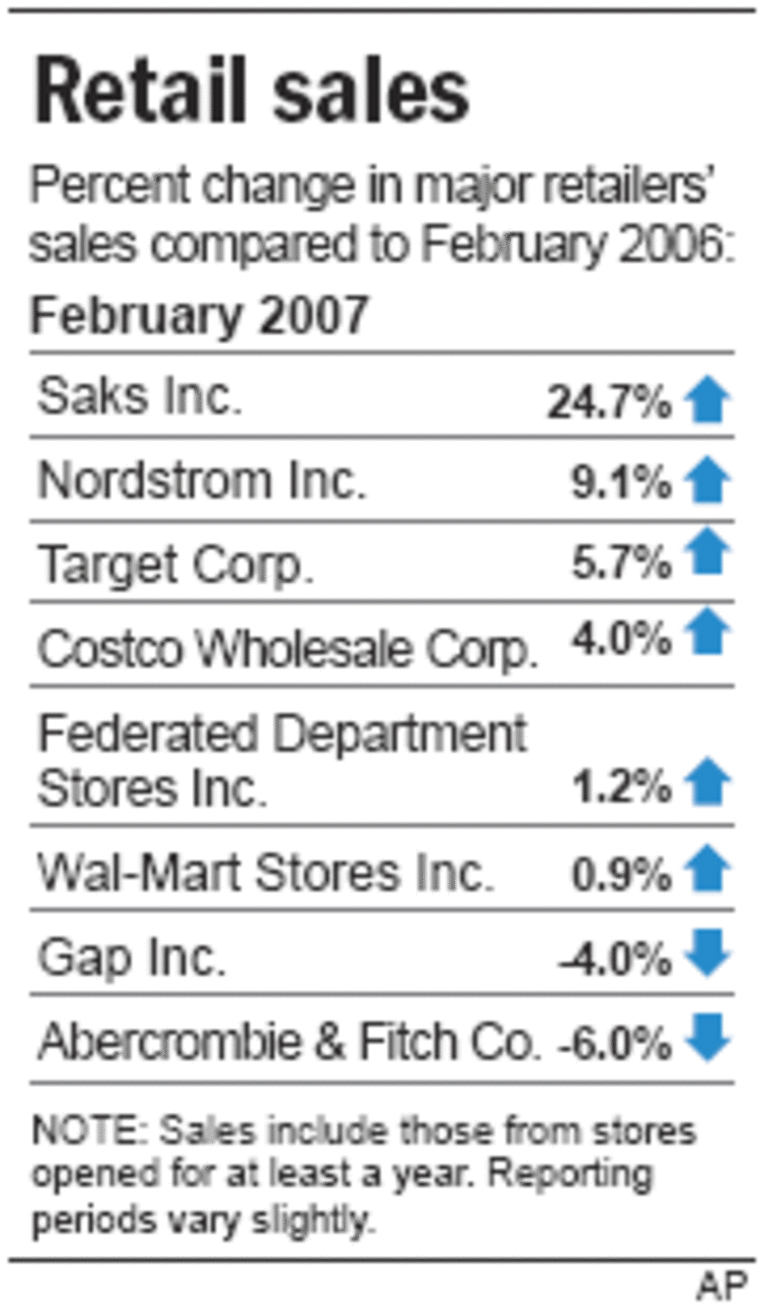The nation’s retailers had a slow start to the spring season as unseasonably cold weather in February chilled demand for lightweight apparel and left merchants with disappointing sales. The slowing economy, particularly the weakening housing market, could challenge shoppers in the months ahead.
As merchants reported monthly sales results early Thursday, those with disappointing results included Wal-Mart Stores Inc., Costco Wholesale Corp. and plenty of apparel stores like Abercrombie & Fitch Co. High-end stores like Nordstrom Inc. continued their winning streak, underscoring that well-heeled consumers don’t buy on need.
“Cooler weather clearly dampened spring apparel sales,” said Ken Perkins, president of RetailMetrics LLC, a research company in Swampscott, Mass. “Customers were not shopping for capri pants.” He noted that winter storms in the Midwest and East Coast hurt Valentine’s Day sales.
But Perkins also said major concerns for consumer spending in the months ahead are the defaults and delinquencies in the mortgage industry. That, coupled with the decline of mortgage equity withdrawals that give consumers extra cash, could curtail spending.
The International Council of Shopping Centers-UBS sales tally for February rose a modest 2.4 percent, below the projected range of 2.5 percent to 3.0 percent. The results are based on sales at stores open at least a year, known as same-store sales and considered a good gauge of a retailer’s health.
The muted sales reports followed a rebound in January, when the late arrival of winter weather helped clear out cold weather items like boots and coats. But that meant there was little for shoppers to buy last month, as they had little interest in spring wear. And some industry watchers are questioning whether shoppers will be drawn to this season’s fashions — styles like mini dresses in bright geometric patterns and baby doll dresses reminiscent of the 1960s.
While February is one of the least important months of a retailer’s calendar, merchants do hope to get some idea of which spring fashion trends are resonating with shoppers. What could help merchants in March is that Easter falls on April 8, about a week earlier than a year ago; that might prompt shoppers to start their Easter-related buying earlier.

Still, there’s concern that shoppers will finally turn frugal because of the housing market’s continuing slump, and that last week’s stock market tumble might also cause shoppers to be more conservative.
There’s also the lingering specter of higher gasoline prices. Gas has jumped above $3 a gallon in some parts of California and Hawaii, and may reach that level in other parts of the country when the summer driving season approaches.
One bright spot is the healthy job market. The Labor Department on Thursday reported that the number of laid-off workers filing claims for unemployment benefits declined by 10,000 last week to 328,000 last week, the lowest level in a month.
Wal-Mart, dragged down by languishing sales at its namesake discount stores, reported a slim 0.9 percent gain in same-store sales, below the 1.5 percent estimate from Wall Street analysts surveyed by Thomson Financial. The Wal-Mart division posted a 0.4 percent same-store sales gain, while Sam’s Club had a 3.9 percent gain.
The world’s largest retailer, which stumbled last year with a merchandising strategy that was too trendy, blamed the sales shortfall on the continued weakness in the home and apparel business. Wal-Mart said those two businesses should remain soft through the spring.
Rival Target Corp. enjoyed a 5.7 percent increase in same-store sales, above the 5.1 percent analyst estimate.
Costco had a 4 percent increase in same-store sales, below the 5.1 percent forecast
Limited Brands Inc. had a 3 percent increase in same-store sales, below the 4 percent estimate. The company had warned that bad weather affected Valentine’s Day sales at its Victoria’s Secret and Bath & Body Works chains.
Bebe Stores Inc. had a 2.2 percent decline in same-store sales, its first monthly decline in 46 months. Analysts expected a 2.2 percent gain.
Long-struggling Gap Inc. had a 4 percent decline in same-store sales, better than the 4.8 percent decline analysts estimated.
Teen retailer Abercrombie & Fitch posted a 6 percent same-store sales drop, worse than the 2.3 percent analysts expected.
Among department stores, Federated Department Stores — which acquired May Department Stores Co. in 2005 and is transforming its Macy’s brand into a national department store chain — reported a 1.2 percent same-store sales, below the 2.8 percent estimate.
“Sales in February were impacted by a series of snow and ice storms in the eastern half of the U.S., including those during the important selling days immediately preceding Valentine’s Day,” said Terry J. Lundgren, chairman, president and CEO in a statement.
Penney had a 0.2 percent decline in same-store sales in its department store business, somewhat better than the 0.5 percent decline analysts expected. The company said sales improved at the end of last month, particularly in areas where the weather turned warm.
Meanwhile, high-end stores continued to shine. Nordstrom reported a 9.1 percent increase in same-store sales in February, beating the 5.7 percent estimate.
On Wednesday, Saks Inc., which operates Saks Fifth Avenue, said its same-store sales surged 24.7 percent, helped by higher sales of full-price merchandise and an end-of-season consolidation sale in certain flagship stores. Analysts expected 6.4 percent.